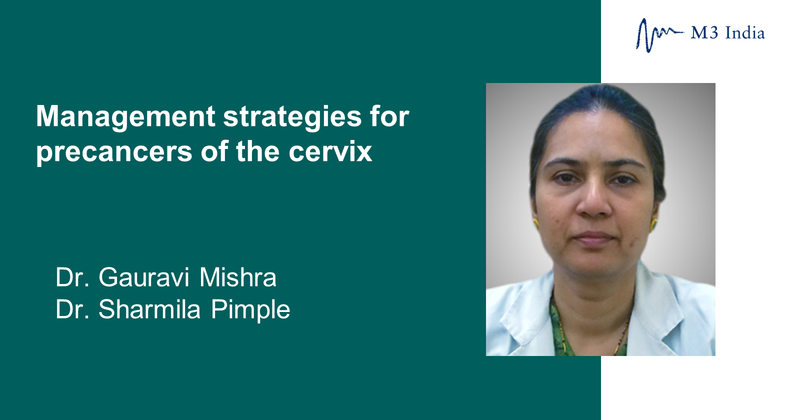Management strategies for precancers of the cervix: Experts from Tata Memorial Hospital
M3 India Newsdesk Dec 19, 2018
Dr. Gauravi Mishra and Dr. Sharmila Pimple, experts in Preventive Oncology at Tata Memorial Hospital (TMH), Mumbai detail on the various management methods available for treating precancers of the cervix.

Appropriate management of screen-positive cervical cancer cases is pivotal for the success of screening programs. Precancers of the cervix can be cured completely by use of prompt treatment and regular follow-up. There are different methods which can be adopted for managing precancers of the cervix. However, for invasive cervical cancers, immediate diagnostic confirmation and treatment are warranted.
Precancerous cells, especially cervical intraepithelial neoplasia CIN 2 and CIN 3 lesions, have a substantially greater cumulative risk of cancer over time. The different treatment strategies available for CIN include careful follow-up, cryotherapy, Loop Electrosurgical Excision Procedure (LEEP), cervical conisation, and laser ablation.
Management strategies for the precancerous stage
Regular follow-up
Cervical intraepithelial neoplasia 1 (CIN 1) comprises of low-grade dysplasia. CIN 1 often goes back to normal without treatment, but regular screening is necessary to confirm the same. Very few cases of CIN 1 fail to regress, and cases which are persistent for 2 years should undergo subsequent treatment.
Cryotherapy
Cryotherapy involves the controlled local destruction of precancerous cells by application of compressed gases. Application of nitrous oxide or carbon dioxide at subfreezing temperatures causes crystallization and subsequent rupture of cell membranes.
Cryotherapy is less effective on severe lesions and lesions located in the endocervical canal. However, it can be used as an affordable first-line treatment for cervical intraepithelial neoplasia (CIN) of any grade.
Loop electrosurgical excision procedure (LEEP)
LEEP involves the application of heat from a high-voltage electrical arc on the cervical transformation zone. This leads to cutting and coagulation of the target area. The excision of the affected epithelium makes a histological examination of the excised tissue possible.
Cervical conisation
Cervical conisation can be used for conservative treatment of cervical intraepithelial neoplasia (CIN) as well a definitive diagnosis of squamous or glandular intraepithelial lesions. The procedure involves excision of a cone-shaped piece of tissue from the cervix uteri.
Conisation guarantees complete removal of precancerous tissues with a success rate reported between 93 and 96%. Cervical stenosis is a rare complication associated with conisation.
Laser ablation
This procedure involves the destruction of tissue at the transformation zone using controlled exposure to a laser beam. Treatment success of laser ablation is reported to be 95 to 96%.
Human Papillomavirus Vaccine
Human papillomavirus (HPV) vaccine offers a promising option for reducing the burden of cervical cancer; however, they cannot substitute the screening and treatment of cervical precancers.
Cervarix (GSK) and Gardasil (Merck) are the two vaccine options available. They confer protection against HPV types 16 and 18, the strains responsible for nearly 70% of cervical cancer. Gardasil also protects against HPV types 6 and 11 which causes genital warts.
Both vaccines are a safe and effective option for women and are recommended to be taken before the onset of sexual activity. Gardasil is also being used for the vaccination of boys in some countries.
However, the high price tag associated with these vaccines act as barriers for its effective implementation. Ongoing research is focusing on the development of HPV vaccines with a broader range of HPV types and fewer doses.
Even though early detection and prompt treatment is one of the priorities of various cancer control programmes, there is a considerable lack of an organised cervical cancer screening program in India. Due to the various technical and financial constraints associated with cytology screening, visual examination, and HPV testing have been suggested as viable alternatives.
Again, the high cost of HPV testing poses as a potential barrier, which makes a visual inspection after application of acetic acid (VIA) as a feasible option for triaging. WHO also recommends VIA-based screen and treatment programs for better compliance with cervical precancer treatment, especially in low economic regions. Currently available vaccines against HPV infections do not protect against all cancer-causing types of HPV and are not affordable, so routine screening is mandatory.
Disclaimer- The views and opinions expressed in this article are those of the author's and do not necessarily reflect the official policy or position of M3 India.
-
Exclusive Write-ups & Webinars by KOLs
-
Daily Quiz by specialty
-
Paid Market Research Surveys
-
Case discussions, News & Journals' summaries